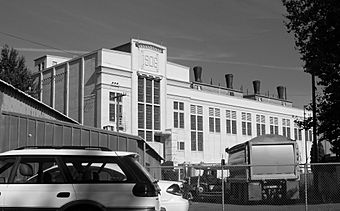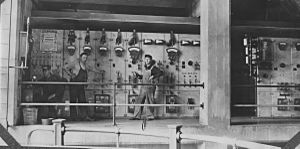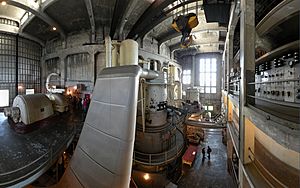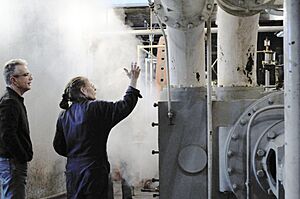Georgetown Steam Plant facts for kids
|
Seattle Electric Company Georgetown Steam Plant
|
|
 |
|
| Location | Seattle, Washington |
|---|---|
| Built | 1906 |
| Architect | Stone & Webster Engineering; Frank B. Gilbreth |
| Architectural style | Classical Revival |
| NRHP reference No. | 78002755 |
Quick facts for kids Significant dates |
|
| Added to NRHP | August 1, 1978 |
| Designated NHL | July 5, 1984 |
The Georgetown Steam Plant is a historic building in Seattle, Washington. It is located in the Georgetown neighborhood. Built in 1906 by the Seattle Electric Company, its main job was to create electricity for Seattle. This power was especially important for the city's streetcars.
Contents
A Look Back: How the Plant Started
The Georgetown Steam Plant was built in 1906 by a company called Stone and Webster. It was one of the first buildings on the U.S. West Coast made with strong, reinforced concrete. The plant first supplied power for the Interurban Railway, which connected Seattle and Tacoma. It also provided direct current for Seattle's streetcars and alternating current for Georgetown, which was an independent city back then.
Amazing Technology of Its Time
The plant used advanced steam turbine technology from General Electric. This technology was based on ideas from inventor Charles Gordon Curtis. At the time, this was super modern! The Georgetown Steam Plant showed a big change in how electricity was made. It marked the start of a new era, moving away from older reciprocating steam engines.
The plant was originally built next to a bend in the Duwamish River. This location was perfect for getting cooling water. However, the river channel was straightened in 1917, leaving the plant further inland. Even after almost 75 years of use, the plant is still "surprisingly complete and operable." It has three Curtis turbines, made by the General Electric Company between 1906 and 1917.
Powering the City and Changes Over Time
In 1912, Puget Sound Traction and Lighting Company bought the Seattle Electric Company. This company is now known as Puget Sound Energy. The Georgetown Steam Plant continued to power the Seattle-to-Tacoma Interurban and Seattle's streetcars. It also supplied electricity to homes and businesses in Georgetown.
The plant first ran on oil. But in 1917, it switched to using coal. As new hydropower dams were built in the 1910s and 1920s, the steam plant became less efficient. It was then mostly used only for emergencies. The last time it produced electricity was in January 1953, when water levels at the dams were low. The plant was officially shut down in 1972.
A Special Place: Landmark and Museum
The Georgetown Steam Plant is a very important building. In 1984, it was named a National Historic Landmark. The American Society of Mechanical Engineers also recognized it as a National Historic Mechanical Engineering Landmark. When it became a landmark, it still had the "last operating examples of the world's first large scale, steam turbine."
The building itself was designed by Frank W. Gilbreth. He was famous for his ideas on making things more efficient. The plant is also a Seattle City Landmark and is listed on the Washington State Register of Historic Places.
Keeping History Alive: The Museum
In 1995, Paul Carosino and Lilly Tellefson started the Georgetown PowerPlant Museum. Their goal was to fix, maintain, and run the plant. Sadly, Paul Carosino passed away in 1996, leaving Lilly Tellefson to continue their work. During this time, programs were created to use the plant to teach people about boilers and steam engines.
Seattle City Light, Seattle's public electric company, still owns the plant. Since 2014, the plant has been open to the public once a month for special open house events. It is home to the last working examples of early vertical Curtis steam turbines. You can also see working reciprocating steam engines and a collection of old machining tools.
New Life for the Plant
On July 12, 2021, the City of Seattle approved a plan for the Georgetown Steam Plant Community Development Authority (GSPCDA) to manage the plant. This new group's mission is to take care of the plant, add new features, and create public programs. These programs focus on history, science, technology, education, arts, and math.
Since then, the plant has hosted more events, including art shows, music performances, and workshops. In 2024, the plant held its first annual Georgetown Steam Plant Science Fair. This event celebrated SHTEAM: Science, History, Technology, Engineering, Art, and Math.




